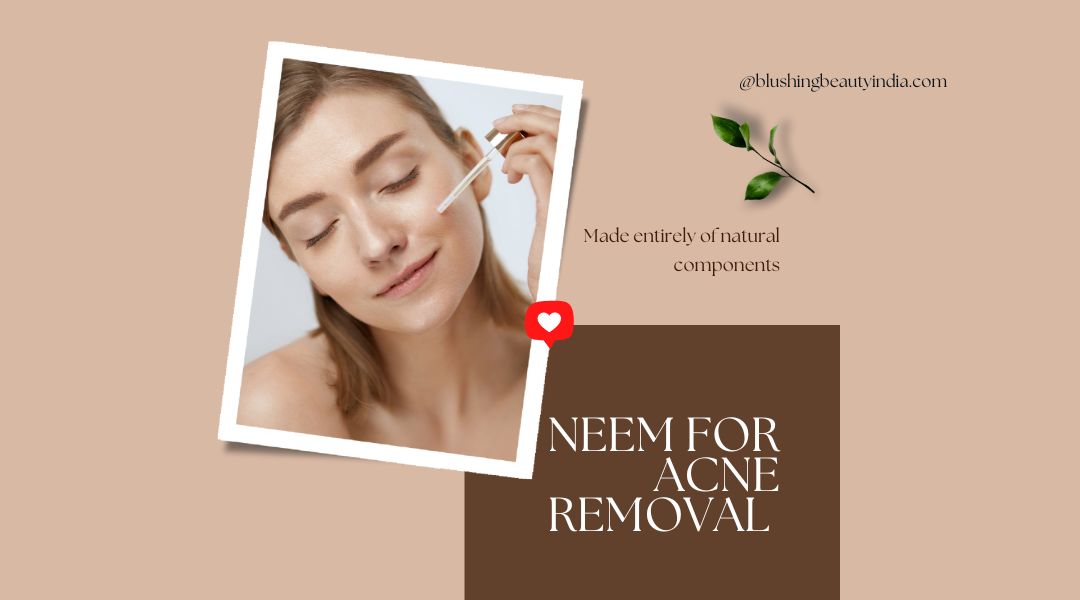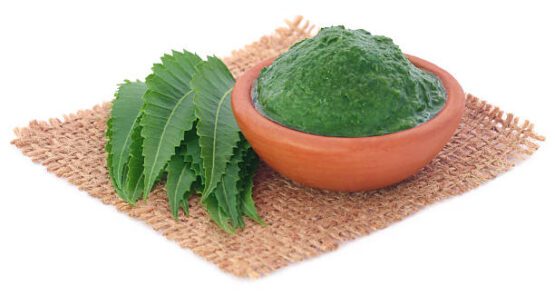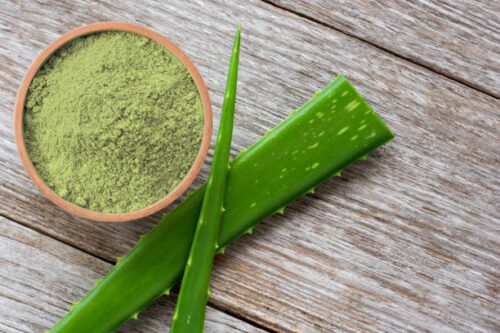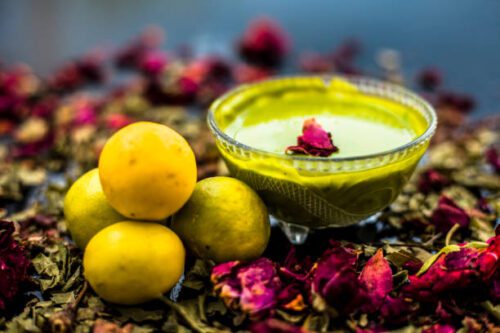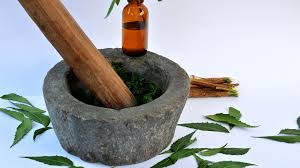Neem, also known as Indian lilac, is a popular natural remedy for treating acne due to its antibacterial, antifungal, and anti-inflammatory properties. Here are the benefits of using neem for acne treatment and a step-by-step guide on how to make and apply neem leaves paste:
Benefits of Using Neem to Cure Acne Naturally:-
- Antibacterial properties: Neem contains compounds that help combat acne-causing bacteria, such as Propionibacterium acnes.
- Anti-inflammatory effects: Neem reduces inflammation and redness associated with acne, helping to calm the skin.
Oil control: Neem can regulate the production of sebum, which helps prevent clogged pores and reduces the likelihood of new acne breakouts. - Antioxidant activity: Neem contains antioxidants that protect the skin from damage caused by free radicals.
1. Apply Neem Leaves Paste to Get Rid of Acne
- Gather neem leaves: Collect a handful of fresh neem leaves. You can find neem leaves at local herbal stores or even grow a neem tree if it’s available in your area.
- Clean the leaves: Wash the neem leaves thoroughly with water to remove any dirt or impurities.
- Grind the leaves: Place the cleaned neem leaves in a blender or mortar and pestle. Grind them until you obtain a smooth paste. You may need to add a small amount of water to help with the grinding process.
- Perform a patch test: Before applying the neem leaf paste to your face, it’s advisable to perform a patch test. Apply a small amount of the paste to a small area of your skin, such as the inside of your forearm. Wait for 24 hours to check for any adverse reactions or allergies.
- Apply the paste: If the patch test does not cause any negative reactions, you can proceed to apply the neem leaf paste to your acne-prone areas. Use your fingertips or a clean cotton ball to apply a thin layer of the paste on the affected areas.
- Leave it on Allow the neem leaf paste to dry on your skin for about 15-20 minutes.
- Rinse off: After the specified time, rinse off the neem leaf paste with lukewarm water. Gently massage your skin while rinsing to help exfoliate dead skin cells.
- Moisturize: After rinsing off the paste, apply a non-comedogenic moisturizer to keep your skin hydrated and balanced.
- Frequency of application: Start by applying the neem leaf paste once a day and observe how your skin responds. If you experience any irritation or dryness, reduce the frequency to every other day or every few days. Adjust the frequency based on your skin’s reaction.
- Remember, natural remedies like neem leaf paste may not work for everyone, and individual results can vary. If you have severe acne or persistent skin issues, it’s recommended to consult with a dermatologist for personalized advice and appropriate treatment options.
2. Apply Neem Oil to Combat Acne
Cleanse your face: Begin by washing your face with a gentle cleanser to remove any dirt, oil, or makeup. Pat your skin dry with a clean towel.
Dilute neem oil: Neem oil is highly concentrated and can be harsh on the skin if used undiluted. Mix a few drops of neem oil with a carrier oil, such as coconut oil, jojoba oil, or almond oil. The recommended ratio is approximately 1 part neem oil to 10 parts carrier oil. This will help reduce the potency of neem oil while still allowing it to be effective.
Perform a patch test: Before applying the diluted neem oil to your face, it’s important to perform a patch test to check for any adverse reactions. Apply a small amount of the diluted mixture to a small area of your skin, such as the inside of your forearm. Wait for 24 hours to see if you experience any redness, itching, or irritation.
Apply to affected areas: If the patch test results are satisfactory and you don’t experience any negative reactions, you can proceed to apply the diluted neem oil to the areas affected by acne. Using a cotton ball or your fingertips, gently apply the mixture to the acne-prone areas. Be careful to avoid the eye and mouth areas.
Leave it on or rinse off: Depending on your preference, you can either leave the neem oil on your skin or rinse it off after 20-30 minutes. Leaving it on overnight can provide better results, but some people may find it too heavy. If you choose to rinse it off, use lukewarm water and a mild cleanser to remove the oil.
Moisturize: After rinsing off the neem oil or allowing it to absorb into your skin, apply a non-comedogenic moisturizer. This will help keep your skin hydrated and prevent excessive dryness.
Frequency of application: Start by applying neem oil once a day and monitor how your skin reacts. If you experience any irritation or dryness, reduce the frequency to every other day or every few days. Adjust the frequency based on your skin’s response and tolerance.
It’s important to note that neem oil may not work for everyone, and individual results may vary. If you have severe acne or persistent skin issues, it’s advisable to consult with a dermatologist for personalized advice and treatment options.
3. Nurturing Nature’s Power: Harnessing Neem and Aloe Vera for Effective Acne Control
- Gather neem leaves and aloe vera gel: Collect a handful of fresh neem leaves and extract the gel from an aloe vera leaf. You can find neem leaves at local herbal stores or grow a neem tree if available in your area. Aloe vera plants can be purchased or you can use store-bought aloe vera gel.
- Clean the neem leaves: Wash the neem leaves thoroughly with water to remove any dirt or impurities.
- Prepare the neem paste: Grind the cleaned neem leaves to a smooth paste using a blender or mortar and pestle. Add a small amount of water if necessary to achieve a paste-like consistency.
- Mix neem paste with aloe vera gel: In a clean bowl, combine the neem paste with an equal amount of aloe vera gel. Mix them well until they are thoroughly blended.
- Perform a patch test: Before applying the neem and aloe vera mixture to your face, perform a patch test on a small area of your skin, such as the inside of your forearm. Wait for 24 hours to check for any adverse reactions or allergies.
- Apply the mixture to your face: If the patch test doesn’t cause any negative reactions, you can proceed to apply the neem and aloe vera mixture to your face. Use your fingertips or a clean cotton ball to apply a thin layer of the mixture to the acne-prone areas of your skin.
- Leave it on for 15-20 minutes: Allow the neem and aloe vera mixture to dry on your skin for about 15-20 minutes. During this time, the mixture can help cleanse your pores and reduce inflammation.
- Rinse off with water: After the specified time, rinse off the mixture with lukewarm water. Gently massage your skin while rinsing to help exfoliate dead skin cells.
- Moisturize your skin: After rinsing off the mixture, apply a non-comedogenic moisturizer to keep your skin hydrated and balanced.
- Frequency of application: Start by using the neem and aloe vera mixture once a day and observe how your skin responds. If you experience any irritation or dryness, reduce the frequency to every other day or every few days. Adjust the frequency based on your skin’s reaction and tolerance.
- Remember, natural remedies may not work for everyone, and individual results can vary. If you have severe acne or persistent skin issues, it’s recommended to consult with a dermatologist for personalized advice and appropriate treatment options.
4. Citrus-Kissed Clear Skin: Unveiling the Magic of Neem and Lemon Juice for Acne Treatment
- Gather neem leaves and a fresh lemon: Collect a handful of fresh neem leaves and a fresh lemon. You can find neem leaves at local herbal stores or grow a neem tree if available in your area.
- Clean the neem leaves: Wash the neem leaves thoroughly with water to remove any dirt or impurities.
- Prepare the neem paste: Grind the cleaned neem leaves to a smooth paste using a blender or mortar and pestle. Add a small amount of water if necessary to achieve a paste-like consistency.
- Extract lemon juice: Squeeze the fresh lemon to extract its juice. Ensure that you remove any seeds or pulp from the juice.
- Mix neem paste with lemon juice: In a clean bowl, combine the neem paste with an equal amount of lemon juice. Mix them well until they are thoroughly blended.
- Perform a patch test: Before applying the neem and lemon juice mixture to your face, perform a patch test on a small area of your skin, such as the inside of your forearm. Wait for 24 hours to check for any adverse reactions or allergies.
- Apply the mixture to your face: If the patch test doesn’t cause any negative reactions, you can proceed to apply the neem and lemon juice mixture to your face. Use your fingertips or a clean cotton ball to apply a thin layer of the mixture to the acne-prone areas of your skin.
- Leave it on for 10-15 minutes: Allow the neem and lemon juice mixture to dry on your skin for about 10-15 minutes. The mixture can help fight bacteria and reduce excess oil on your skin.
- Rinse off with water: After the specified time, rinse off the mixture with lukewarm water. Gently massage your skin while rinsing to help exfoliate dead skin cells.
- Moisturize your skin: After rinsing off the mixture, apply a non-comedogenic moisturizer to keep your skin hydrated and balanced.
- Frequency of application: Start by using the neem and lemon juice mixture once a day and observe how your skin responds. If you experience any irritation or dryness, reduce the frequency to every other day or every few days. Adjust the frequency based on your skin’s reaction and tolerance.
Please note that lemon juice can be drying and may cause sensitivity to sunlight. It’s essential to use sunscreen and avoid sun exposure when using lemon juice on your skin. If you have severe acne or persistent skin issues, it’s recommended to consult with a dermatologist for personalized advice and appropriate treatment options.
5. Nature’s Dynamic Duo: Exploring Neem and Sandalwood’s Synergy for Acne Eradication
6. Blooms of Clarity: Uniting Neem and Rose Water for Acne Relief and Radiant Skin
- Gather the ingredients: You will need neem leaves or neem powder and rose water. Neem leaves can be found at some herbal stores, while neem powder is available online or in health food stores. Rose water is commonly available at cosmetic stores or can be made at home by steeping rose petals in water.
- Prepare neem paste: If you are using neem leaves, crush a handful of fresh neem leaves into a paste using a mortar and pestle. If you have neem powder, mix it with a small amount of water to form a paste. Ensure that the paste has a smooth consistency.
- Mix with rose water: Once you have the neem paste ready, add a few drops of rose water to it. Rose water helps to balance the pH of the skin and provides a soothing effect.
- Apply the mixture: Wash your face with a gentle cleanser and pat it dry. Take a small amount of the neem and rose water mixture and apply it directly to the affected areas of your skin using clean fingertips or a cotton ball. Gently massage the mixture into your skin in circular motions.
- Leave it on Allow the neem and rose water mixture to dry on your skin. Depending on the consistency of the paste, it may take around 15-20 minutes to dry.
- Rinse off: Once the mixture is completely dry, rinse it off with lukewarm water. Make sure to remove all traces of the paste from your skin.
- Moisturize: After rinsing off the neem and rose water mixture, apply a light moisturizer suitable for your skin type to keep your skin hydrated.
- Repeat regularly: For best results, repeat this process 2-3 times a week. Consistency is key to seeing improvements in your acne.
Neem has antibacterial and antifungal properties, while rose water helps to soothe and tone the skin. This combination can be beneficial in reducing acne and its associated inflammation. However, it’s important to note that individual results may vary, and if you have severe acne, it’s best to consult a dermatologist for an appropriate treatment option

